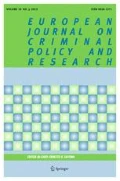References
Black, D. (1983). Crime as social-control. American Sociological Review, 48(1), 34–45.
DeKeseredy, W. S., Saunders, D. G., Schwartz, M. D., & Shahid, A. (1997). The meanings and motives for women's use of violence in Canadian college dating relationships: Results from a National Survey. Sociological Spectrum, 17, 199–222.
Durose, M. R., Wolf Harlow, C., Langan, P. A., Motivans, M., Rantala, R. R., & Smith, E. L. (2005). Family violence statistics including statistics on strangers and acquaintances (No. NCJ 207846). Washington, DC.: U.S. Department of Justice, Office of justice Programs, Bureau of Justic Statistics.
Feld, S. L., & Straus, M. A. (1989). Escalation and desistance of wife assault in marriage. Criminology, 27(1), 141–161.
Gelles, R. J. (1980). Violence in the family: A review of research in the seventies. Journal of Marriage and the Family, 42, 873–885.
Giles-Sims, J. (1983). Wife battering: A systems theory approach. New York: Guilford Press.
Hamel, J., & Nicholls, T. (Eds.). (2006). Family approaches in domestic violence: A practitioner’s guide to gender-inclusive research and treatment: Springer.
Holtzworth-Munroe, A. (2005). Female perpetration of physical aggression against an intimate partner: A controversial new topic of study. Violence and Victims, 20(2), 251–259.
Johnson, H., & Sacco, V. F. (1995). Researching violence against women: Statistics canada’s national survey. Canadian Journal of Criminology, 281–304, July.
Johnson, M. P., & Ferraro, K. J. (2000). Research on domestic violence in the 1990's: Making distinctions. Journal of Marriage and the Family, 62(4), 948–963.
Johnson, M. P., & Leone, J. M. (2005). The differential effects of intimate terrorism and situational couple violence - findings from the national violence against women survey. Journal Of Family Issues, 26(3), 322–349.
Kaufman Kantor, G., & Straus, M. A. (1987). The drunken bum theory of wife beating. Social Problems, 34, 213–230.
Kennedy, L. W., & Dutton, D. G. (1989). The incidence of wife assault in alberta. Canadian Journal of Behavioral Science, 21(1), 40–54.
Kernsmith, P. (2005). Exerting power or striking back: A gendered comparison of motivations for domestic violence perpetration. Victims and Violence, 20(2), 173–185.
Krug, E. G., Dahlberg, L. L., Mercy, J. A., Zwi, A. B., Lozano, R., & World Health Organization. (2002). World report on violence and health. Geneva: World Health Organization.
Lackey, C., & Williams, K. R. (1995). Social bonding and the cessation of partner violence across generations. Journal of Marriage and the family, 57, 295–305.
Lupri, E. (2004). Institutional resistance to acknowledging intimate male abuse, Counter-Roundtable Conference on Domestic Violence. Calgary, Alberta, Canada.
Medeiros, R. A., & Straus, M. A. (2006). Risk factors for physical violence between dating partners: Implications for gender-inclusive prevention and treatment of family violence. In J. C. Hamel & T. Nicholls (Eds.), Family approaches to domestic violence: A practioners guide to gender-inclusive research and treatment. Springer (also available at http://pubpages.unh.edu/~mas2).
Saunders, D. G. (1986). When battered women use violence: Husband-abuse or self-defense? Violence and Victims, 1(1), 47–60.
Schulman, M. (1979). A survey of spousal violence aqainst women in Kentucky. Washington, DC: U.S. Government Printing Office.
Steinmetz, S. K. (1977). The cycle of violence: Assertive, aggressive, and abusive family interaction. New York: Praeger.
Steinmetz, S. K. (1977–1978). The battered husband syndrome. Victimology, 2, 499–509.
Straus, M. A. (1999). The controversy over domestic violence by women: A methodological, theoretical, and sociology of science analysis. In X. Arriaga & S. Oskamp (Eds.), Violence in intimate relationships (pp. 17–44). Thousand Oaks, CA: Sage.
Straus, M. A. (2006). Dominance and symmetry in partner violence by male and female university students in 32 nations. Paper presented at the Trends in intimate violence intervention conference, New York University, 23 May.
Straus, M. A., & International Dating Violence Research Consortium. (2004). Prevalence of violence against dating partners by male and female university students worldwide. Violence Against Women, 10(7), 790–811.
Straus, M. A., & Scott, K. (In press). Gender symmetry in partner violence: The evidence, the denial, and the implications for primary prevention and treatment. In J. R. Lutzker & D. J. Whitaker (Eds.), Prevention of partner violence. Washington D.C. : American Psychological Association.
Straus, M. A., Hamby, S. L., Boney-McCoy, S., & Sugarman, D. B. (1996). The revised conflict tactics scales (CTS2): Development and preliminary psychometric data. Journal of Family Issues, 17(3), 283--316.
Tjaden, P., & Thoennes, N. (2000). Full report of the prevalence, incidence, and consequences of violence against women: Findings from the national violence against women survey (No. NCJ 183781). Washington, DC: U.S. Department of Justice, Office of Justice Programs.
Author information
Authors and Affiliations
Corresponding author
Additional information
Copies of related papers are available at http://pubpages.unh.edu/~mas2. The work has been supported by National Institute of Mental Health grant T32MH15161 and by the University of New Hampshire.
Rights and permissions
About this article
Cite this article
Straus, M.A. Processes Explaining the Concealment and Distortion of Evidence on Gender Symmetry in Partner Violence. Eur J Crim Policy Res 13, 227–232 (2007). https://doi.org/10.1007/s10610-007-9060-5
Received:
Accepted:
Published:
Issue Date:
DOI: https://doi.org/10.1007/s10610-007-9060-5

